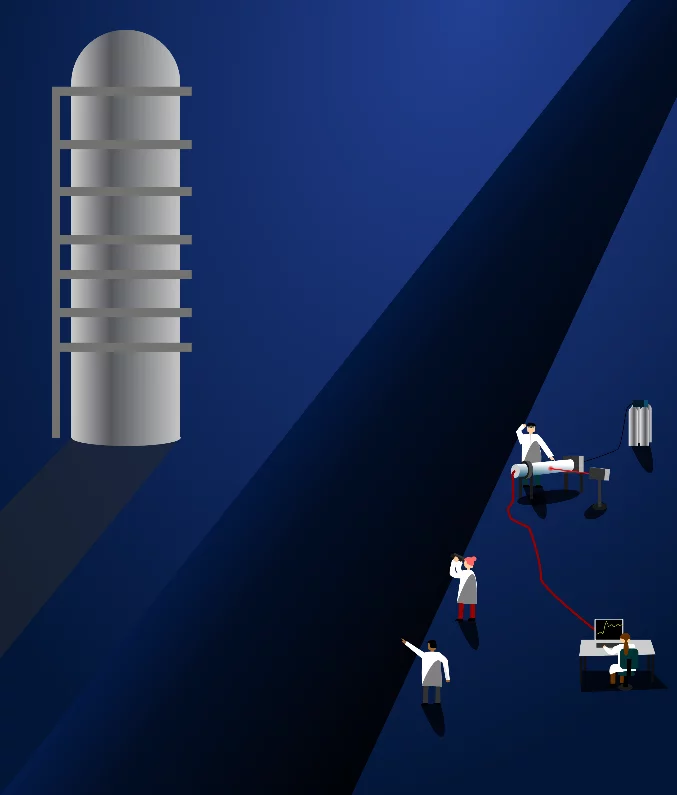Many types of catalysts have been well known for decades, but the fundamental understanding as to why they work so well is still not quite clear. Without this understanding, an even more efficient catalyst cannot be developed, which is needed to reduce the global energy demand. Copper-zinc-alumina (CZA) is a popular catalyst and has been used for about 100 years, as it facilitates the production of the important chemical building block methanol, a molecule that enables the storage of hydrogen in a manner that minimizes negative impact on the carbon-dioxide footprint. Until 2021, scientists debated over the reason why the catalyst works so well. Understanding the reason behind this is vital in order to further develop even better ones. The copper-zinc-alumina (CZA) catalyst is assessed at the Laboratory for catalysis and sustainable chemistry (LSK) of the Paul Scherrer Institute.
Understanding catalyst efficiency
The methanol which is produced with the help of the CZA catalyst can be used in the transportation industry by producing new fuels, such as jet fuel. It is also widely used in the production of plastics and pharmaceuticals – this means in everyday products. This makes it all the more important to manufacture the molecule in a renewable fashion, by using the CO₂ that has already been emitted into the air and thereby reducing emissions in the production of methanol - as opposed to the previously used carbon monoxide from fossil fuels. It is important to reach an understanding of why this catalyst was working so well with the former approach by using carbon monoxide from fossil fuels, and why it is not working as well with the use of carbon dioxide.
Boundary conditions as important indicators
At the laboratory for catalysis and sustainable chemistry, the focus is set on getting to the bottom of what causes such differences in terms of efficiency, in an effort to develop an even more efficient catalyst for a renewable process. Nowadays, sophisticated tools, for example, the synchrotron radiation from the Swiss Light Source, are used to gain this understanding. The issue is, that different methods used to comprehend the process have different technical limitations. It would be ideal to replicate the same conditions that are present in the industrial process, but attempting this in the research laboratories poses some challenges: Experiments in a laboratory environment are conducted on a much smaller scale than in the industrial processes. Further, high pressures are needed to make methanol, and a big reactor with steel walls, strong enough to withstand high pressure so as to not explode, is required. Oftentimes in laboratories, in methods where the structure of the process can be observed during its operation, glass instead of steel walls are used. As the reactor setup is penetrated by x-rays, the glass is not strong enough to withstand the pressure of those 100 bars.
An easier way would be to work at lower pressures, ignoring real industrial conditions. The problem in using such an approach is that catalysts are extremely sensitive to pressure. Different pressure conditions lead to different states and thereby produce different end-products. Taking coffee for example, Arik Beck, PhD at the LSK, explains, that different pressure makes different quality coffee. In research, different groups use different pressure conditions in their studies resulting in outcome discrepancies. To investigate this further, the LSK decided to look at different pressure conditions in order to establish a unified understanding of which one of these conditions is responsible for the best performance. This will then be used as the main structure, to improve the process further. Oftentimes, boundary conditions such as pressure are overlooked. Many previously labeled “inconclusive results” can be explained by this mismatch in pressure conditions, which resulted in different outcomes and findings.
Replicating industrial conditions
The operating conditions which were identified in recent work, especially the significance of the pressure conditions, are essential for understanding the industrial process. Therefore, the LSK is now working on having reactor cells that will give information throughout the operation but are simultaneously able to withstand the high industrial process pressures. With these experiments, the CZA catalysts may be finally used to reduce CO2 emissions.
Text by Michelle Kalousek in an interview with Arik Beck
Contact
Arik Beck
PhD Student Laboratory for catalysis and sustainable chemistry
Paul Scherrer Institute
Forschungsstrasse 111
5232 Villigen PSI
Switzerland
Telephone: +41 56 310 40 85
Email: arik.beck@psi.ch


